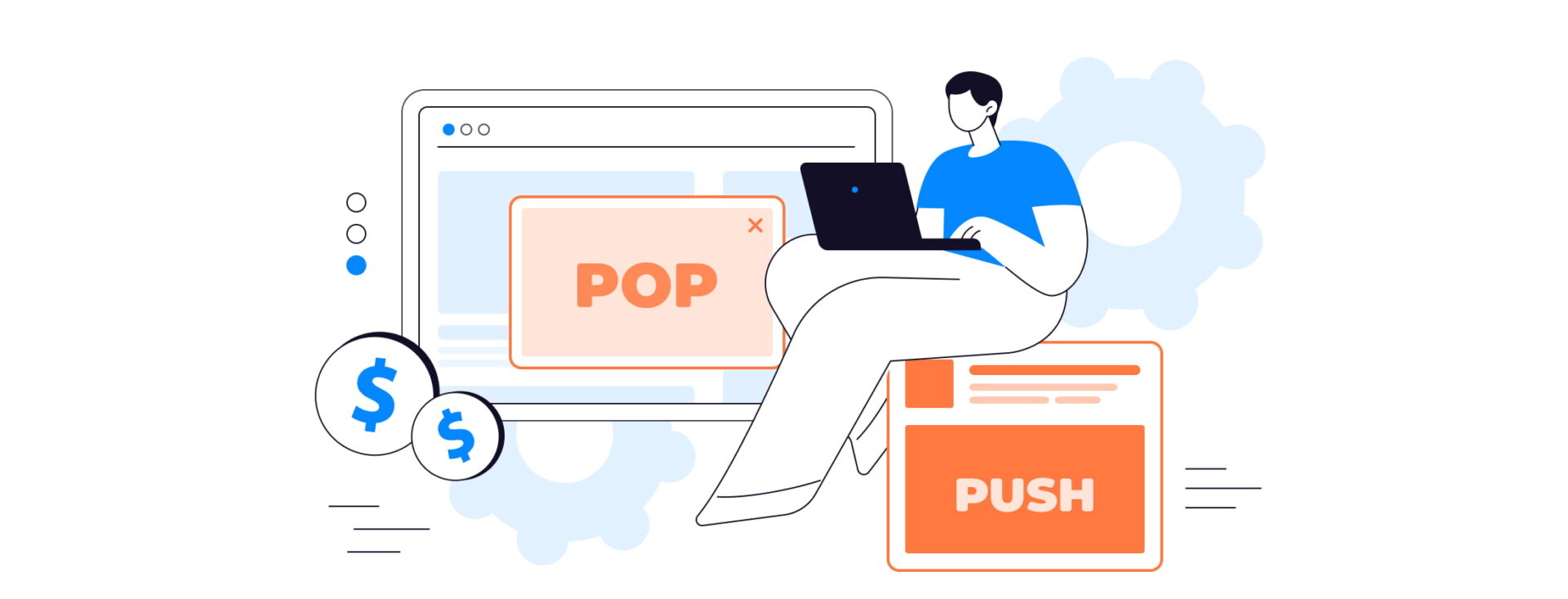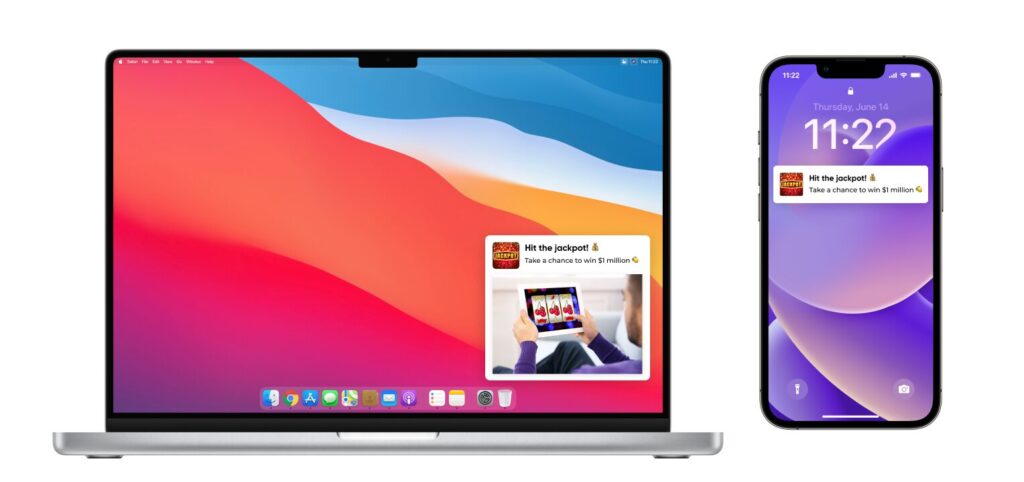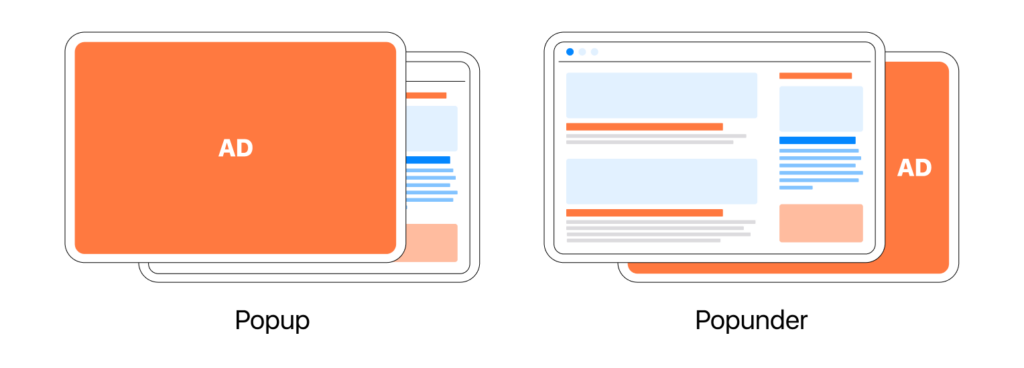
Push ads and pop ads (commonly referred to as “pops”) might seem worlds apart at first glance, but dig a little deeper, and you’ll find they share quite a few traits. Think of them as siblings – each with unique features, bound by certain similarities.
In this article, we’ll break down both formats, highlight their pros and cons, and help you decide when to use push ads or pops to maximize your results.
Push ads are non-intrusive, clickable notifications that appear directly on a user’s device, whether on desktop or mobile. These ads mimic standard notifications from apps or websites, blending seamlessly with everyday user flow.

The mechanism behind push ads relies on users opting in to receive notifications from a website or app. Once subscribed, these users become part of the ad network’s database, allowing advertisers to reach them with targeted campaigns. Notifications are delivered directly to the device, even if the user is not actively browsing.
From a technical standpoint, push ads are delivered via browser notifications (on desktop) or system notifications (on mobile). Parts include a title, description, main image, and button featuring a call-to-action (optionally).
The common pricing model for purchasing push notifications traffic is CPC (cost per click).
Advantages of push ads:
Disadvantages of push ads:
Verdict:
Push ads combine personalization with high visibility, making them an ideal format for driving engagement and conversions. Their opt-in nature ensures a more receptive audience, while advanced targeting options and cost-effective bidding models make them a must-try for affiliate marketers.
Push ads are ideal for campaigns that focus on engagement, like promoting apps, subscription offers, or e-commerce deals. They’re best used in verticals like Dating, Gambling, Nutra, E-commerce, and Finance, where a personalized touch can drive better conversions.
Pop ads (popunders) open a new browser tab or window in the background, displaying your offer after the user interacts with the main website. This format is considered one of the oldest in marketing and continues to deliver high-volume pop traffic, despite the widespread adoption of other advertising methods.
There are 2 variations of pops: popup and popunder.

The technology behind pop ads relies on JS scripts embedded into a publisher’s website. When a user interacts with the site, the script triggers a new browser tab or window to open in the background. This tab contains the advertiser’s landing page or offer.
Pop ad traffic is generally sold on CPM (Cost Per Mille), when advertisers pay for every 1000 impressions. Some networks also offer Smart CPM, where advertisers compete for traffic, with bids adjusting automatically to match demand and supply.
Verdict:
Pop ads are particularly effective for high-volume campaigns. Their cost-efficiency and scalability make them ideal for generating large amounts of traffic. Pops can access a wider audience, since they’re less dependent on opt-in systems like push ads. They work well for gambling, antivirus, utilities, and sweepstakes offers.
As for GEOs, pop and popunder ads are perfect for tier-2 and tier-3 geos, where ad blockers are less prevalent.
When deciding between push ads and pops for your campaign, understanding their differences and similarities can help you choose the right format for your goals.
Here’s a detailed comparison:
| Aspect | Push ads | Popunder |
|---|---|---|
| Delivery | Notifications appear directly on the user’s device (desktop or mobile) after opt-in. | Opens a new browser tab or window in the background after user interaction with a site. |
| Audience engagement | High engagement due to opt-in users who are more likely to interact with the ad. | Lower engagement as ads are displayed to a broad audience, including uninterested users. |
| Reach | Limited to users who have opted into notifications. | Broad reach without requiring opt-in; ideal for scaling. |
| Pricing models | CPC (Cost Per Click), CPM (Cost Per Mille) | Typically CPM (Cost Per Mille) |
| Traffic volume | Moderate traffic volume due to limited audience size. | High traffic volume; perfect for scaling campaigns. |
| Ad format | Short text, image, and CTA resembling native notifications. | Full landing pages, videos, or interactive content for comprehensive marketing. |
| Best verticals | Finance, Dating, E-Commerce, Nutra and other niches requiring trust and engagement. | Gambling, Antivirus, Utilities, Sweepstakes, and other high-volume verticals. |
| Cost | Higher CPC compared to pops but often more targeted and efficient. | Lower CPM, making it budget-friendly for large-scale campaigns. |
| Geo performance | Excels in tier-1 geos where users engage more with notifications. | Highly effective in tier-2 and tier-3 geos with fewer ad blockers. |
| Ad blocker impact | Minimal impact as push ads rely on user opt-in. | More susceptible to ad blockers, although many networks use anti-ad block technology. |
Choosing between push ads and pops depends on several factors, including your campaign goals, budget, target audience, and vertical. Each format offers unique advantages and is better suited to specific scenarios. Let’s dive deeper into when to use each format to get the best results.
Push ads are perfect for campaigns where engagement and quality traffic are key priorities. These ads are delivered directly to users who have opted in, making the audience more receptive to your offers.
Pops (popunders) are your go-to format for scaling quickly and generating large amounts of traffic. They focus on delivering sheer volume, making them a strong contender for aggressive testing and high-visibility campaigns.
For maximum impact, consider using both formats in your campaigns. Start with the best pop ad networks to generate traffic and test the performance of your offer. Use push ads to engage the most responsive audience segments and scale conversions.
Push ads and pops are like tools in your affiliate marketing toolbox – each designed for different tasks. By understanding their strengths and weaknesses, you can craft campaigns that hit your goals while maximizing your ROI. Ready to choose your format? Dive into testing and see which one brings the best results for your vertical!
Push ads and pop ads (commonly referred to as “pops”) might seem worlds apart at first glance, but dig a little deeper, and you’ll find they share quite a few traits. Think of them as siblings – each with unique features, bound by certain similarities.
In this article, we’ll break down both formats, highlight their pros and cons, and help you decide when to use push ads or pops to maximize your results.
Push ads are non-intrusive, clickable notifications that appear directly on a user’s device, whether on desktop or mobile. These ads mimic standard notifications from apps or websites, blending seamlessly with everyday user flow.

The mechanism behind push ads relies on users opting in to receive notifications from a website or app. Once subscribed, these users become part of the ad network’s database, allowing advertisers to reach them with targeted campaigns. Notifications are delivered directly to the device, even if the user is not actively browsing.
From a technical standpoint, push ads are delivered via browser notifications (on desktop) or system notifications (on mobile). Parts include a title, description, main image, and button featuring a call-to-action (optionally).
The common pricing model for purchasing push notifications traffic is CPC (cost per click).
Advantages of push ads:
Disadvantages of push ads:
Verdict:
Push ads combine personalization with high visibility, making them an ideal format for driving engagement and conversions. Their opt-in nature ensures a more receptive audience, while advanced targeting options and cost-effective bidding models make them a must-try for affiliate marketers.
Push ads are ideal for campaigns that focus on engagement, like promoting apps, subscription offers, or e-commerce deals. They’re best used in verticals like Dating, Gambling, Nutra, E-commerce, and Finance, where a personalized touch can drive better conversions.
Pop ads (popunders) open a new browser tab or window in the background, displaying your offer after the user interacts with the main website. This format is considered one of the oldest in marketing and continues to deliver high-volume pop traffic, despite the widespread adoption of other advertising methods.
There are 2 variations of pops: popup and popunder.

The technology behind pop ads relies on JS scripts embedded into a publisher’s website. When a user interacts with the site, the script triggers a new browser tab or window to open in the background. This tab contains the advertiser’s landing page or offer.
Pop ad traffic is generally sold on CPM (Cost Per Mille), when advertisers pay for every 1000 impressions. Some networks also offer Smart CPM, where advertisers compete for traffic, with bids adjusting automatically to match demand and supply.
Verdict:
Pop ads are particularly effective for high-volume campaigns. Their cost-efficiency and scalability make them ideal for generating large amounts of traffic. Pops can access a wider audience, since they’re less dependent on opt-in systems like push ads. They work well for gambling, antivirus, utilities, and sweepstakes offers.
As for GEOs, pop and popunder ads are perfect for tier-2 and tier-3 geos, where ad blockers are less prevalent.
When deciding between push ads and pops for your campaign, understanding their differences and similarities can help you choose the right format for your goals.
Here’s a detailed comparison:
| Aspect | Push ads | Popunder |
|---|---|---|
| Delivery | Notifications appear directly on the user’s device (desktop or mobile) after opt-in. | Opens a new browser tab or window in the background after user interaction with a site. |
| Audience engagement | High engagement due to opt-in users who are more likely to interact with the ad. | Lower engagement as ads are displayed to a broad audience, including uninterested users. |
| Reach | Limited to users who have opted into notifications. | Broad reach without requiring opt-in; ideal for scaling. |
| Pricing models | CPC (Cost Per Click), CPM (Cost Per Mille) | Typically CPM (Cost Per Mille) |
| Traffic volume | Moderate traffic volume due to limited audience size. | High traffic volume; perfect for scaling campaigns. |
| Ad format | Short text, image, and CTA resembling native notifications. | Full landing pages, videos, or interactive content for comprehensive marketing. |
| Best verticals | Finance, Dating, E-Commerce, Nutra and other niches requiring trust and engagement. | Gambling, Antivirus, Utilities, Sweepstakes, and other high-volume verticals. |
| Cost | Higher CPC compared to pops but often more targeted and efficient. | Lower CPM, making it budget-friendly for large-scale campaigns. |
| Geo performance | Excels in tier-1 geos where users engage more with notifications. | Highly effective in tier-2 and tier-3 geos with fewer ad blockers. |
| Ad blocker impact | Minimal impact as push ads rely on user opt-in. | More susceptible to ad blockers, although many networks use anti-ad block technology. |
Choosing between push ads and pops depends on several factors, including your campaign goals, budget, target audience, and vertical. Each format offers unique advantages and is better suited to specific scenarios. Let’s dive deeper into when to use each format to get the best results.
Push ads are perfect for campaigns where engagement and quality traffic are key priorities. These ads are delivered directly to users who have opted in, making the audience more receptive to your offers.
Pops (popunders) are your go-to format for scaling quickly and generating large amounts of traffic. They focus on delivering sheer volume, making them a strong contender for aggressive testing and high-visibility campaigns.
For maximum impact, consider using both formats in your campaigns. Start with the best pop ad networks to generate traffic and test the performance of your offer. Use push ads to engage the most responsive audience segments and scale conversions.
Push ads and pops are like tools in your affiliate marketing toolbox – each designed for different tasks. By understanding their strengths and weaknesses, you can craft campaigns that hit your goals while maximizing your ROI. Ready to choose your format? Dive into testing and see which one brings the best results for your vertical!